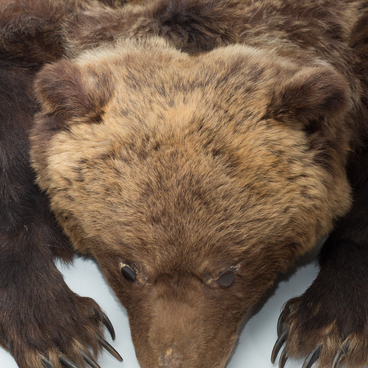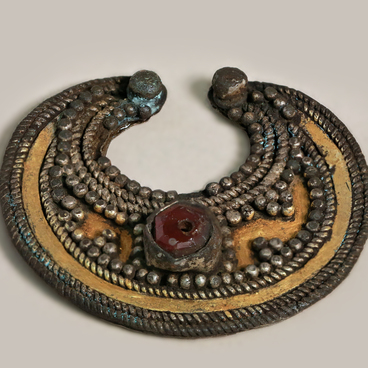Perm animal style is a kind of bronze metal plastics produced by medieval Ural craftsmen. In the 6th — 13th centuries, this type of casting was widely popular in the Urals, Trans-Urals, and the taiga zone of the Ob River. The artifacts were discovered with buried treasures, in burials, and at former sites of the metallurgical complexes. Researchers suggest that in the metal, craftsmen depicted spirits, tribal and personal totems — creatures or objects that were deemed tribes ancestors or patrons. Such items were of a cult nature; they were used in sacred rituals, such as shaman’s interaction with the spirit world.
The plots with a bear and an elk were the most frequent in the Perm animal style. The elk cult among the Khanty, inhabiting the Nefteyugansk District, does not stand out conspicuously nowadays. However, the bear cult has persisted for more than a millennium. The Khanty and some other indigenous peoples of Western Siberia still celebrate “Bear Feast” — a set of rituals following the successful bear hunt. The animal carcass is dressed, the hide is laid in a sacrificial pose — the head is between the paws of a bear — and the meat is boiled. The ceremonies are accompanied by playing musical instruments, ritual and entertainment dances, and singing.
An open-work bronze buckle with zoomorphic ornament is displayed at the exhibition “Ugra Heritage”. It was received by the Museum of the Ob River funds in 1997 after the excavations of the archaeological site Kintusovskoye 4 near Lake Syrkovy Sor. The outer side of the buckle is polished, the reverse is untreated. An image of a bear in the sacrificial pose is depicted on the face plate. The bear’s forelegs are covered with a row of round semi-bead ornaments. The same ornaments are along the spine bone and at the connection point. There is an image of two elk heads facing in opposite directions on the frame.
For medieval inhabitants of the Salym District, the bear image had protective and magical functions. It was considered a male sign. The image of this animal on the hunter’s belt buckle should protect him from evil spirits and bring good fortune in the hunt.
The plots with a bear and an elk were the most frequent in the Perm animal style. The elk cult among the Khanty, inhabiting the Nefteyugansk District, does not stand out conspicuously nowadays. However, the bear cult has persisted for more than a millennium. The Khanty and some other indigenous peoples of Western Siberia still celebrate “Bear Feast” — a set of rituals following the successful bear hunt. The animal carcass is dressed, the hide is laid in a sacrificial pose — the head is between the paws of a bear — and the meat is boiled. The ceremonies are accompanied by playing musical instruments, ritual and entertainment dances, and singing.
An open-work bronze buckle with zoomorphic ornament is displayed at the exhibition “Ugra Heritage”. It was received by the Museum of the Ob River funds in 1997 after the excavations of the archaeological site Kintusovskoye 4 near Lake Syrkovy Sor. The outer side of the buckle is polished, the reverse is untreated. An image of a bear in the sacrificial pose is depicted on the face plate. The bear’s forelegs are covered with a row of round semi-bead ornaments. The same ornaments are along the spine bone and at the connection point. There is an image of two elk heads facing in opposite directions on the frame.
For medieval inhabitants of the Salym District, the bear image had protective and magical functions. It was considered a male sign. The image of this animal on the hunter’s belt buckle should protect him from evil spirits and bring good fortune in the hunt.

